Apple's iPhone 4: Thoroughly Reviewed
by Brian Klug & Anand Lal Shimpi on June 30, 2010 4:06 AM EST- Posted in
- Smartphones
- Apple
- iPhone 4
- Gadgets
- Mobile
Performance
When the 4 was announced, my curiosity (and perhaps yours as well?) was about the flavor of Apple’s A4 SoC inside the phone. The rumor was that the A4 in the iPhone 4 had a full 512MB of memory, compared to 256MB in the iPad’s A4. iFixit took an iPhone 4 apart (with relative ease I might add) and confirmed the presence of 512MB. Look at the A4 in this picture, the Samsung part number on the right edge of the chip starts out K4X4G. The K4X denotes a Samsung mobile DRAM and the 4G refers to its density: 4Gbit or 512MB.
More memory should mean a smoother multitasking experience on the iPhone 4. Remember that iOS 4 keeps all fast task switching enabled apps resident in memory even after you’ve switched away from them. They are only kicked out of memory if you run low or if you force quit them. With more memory you should be able to keep more apps in memory without unwillingly forcing them out. The 512MB of RAM should also give the OS more breathing room in lighter multitasking scenarios, a problem many are already seeing on the iPhone 3GS running iOS 4. In practice the 4 is smoother when running iOS 4. There are still some hiccups but not as bad as on the 3GS, and definitely not as bad as on the 3G. The OS was clearly designed with the iPhone 4 as the performance target.
The big question that remains is what clock speed the iPhone 4’s A4 is running at. The assumption was 1GHz however Apple was very careful not to mention clock speed, unlike at the iPad launch. Saying nothing usually means there’s nothing good to say.
I ran a whole bunch of benchmarks on the iPhone 4 and the iPhone 3GS running iOS 4 to try and figure out what CPU speed we might be dealing with. The early reviews imply that the A4 in the iPhone 4 is running at a speed greater than the 3GS’s 600MHz, but slower than the iPad’s 1GHz. Let’s try and find out what it’s really running at.
We’ll start with the real world tests, first SunSpider. A javascript performance test this benchmark is completely network independent but it measures the performance of the browser as well as the underlying hardware. It is small enough to make memory size differences negligible so between the two iPhones we should be seeing a pure CPU comparison:
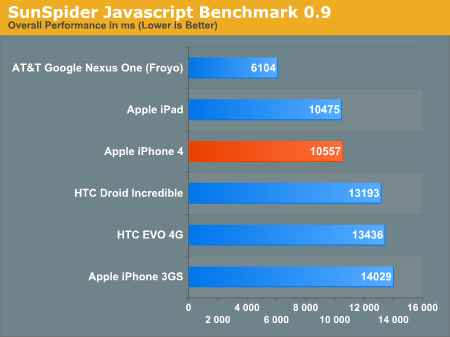
The iPhone 4 manages a time that’s 25% faster. Note that this test is just as much about the software stack as it is about CPU/platform performance. The Froyo update makes the Nexus One ridiculously fast in this benchmark. It just shows you how much room there is to improve performance on these Android handsets. The next leapfrog is going to be once the entire Android world moves to 2.2.
Next up is the Rightware BrowserMark. This test combines JavaScript and HTML rendering performance:
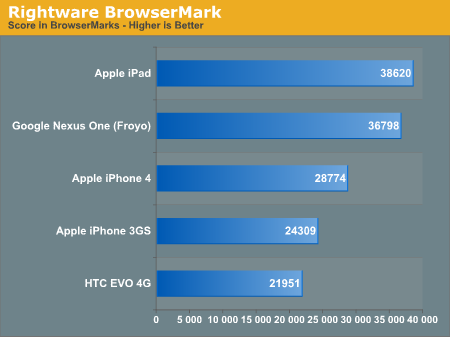
BrowserMark spits out an overall score but with no indication of what the score actually means. In this case we’re looking at 18.4% better performance than the iPhone 3GS. The iPad is 34% faster than the 4, which supports the theory of the A4 running at ~750MHz in the new iPhone.
There's also the possibility that the A4 CPU clock varies depending on load and other factors but the run to run consistency in all of our tests seems to indicate otherwise. We also can't ignore the fact that the iPad and iPhone now run vastly different OS revisions. In some cases iOS 4 actually takes a step back in performance compared to iOS 3.2. That undoubtedly makes the iPad vs. iPhone 4 comparison about much more than CPU performance.
Froyo's improved Javascript performance sends the Nexus One nearly to the top of the list here, only bested by the iPad. While Apple has definitely improved performance with the iPhone 4, it seems that it will only take a software update for Android phones to surpass it.
To measure web browsing performance I downloaded a bunch of different web pages and saved as much of them as possible locally on a server. I used WiFi on all of the devices to connect to my local server and timed average load time. I repeated the test at least 3 times and threw out any unusually high or low numbers. Performance was from a clean restart with no additional programs running in memory.
Note that these numbers aren't comparable to other reviews as we've updated software versions on two of the phones. The iPhone 3GS is now running iOS 4 which resulted in some numbers going up while others went down. And the Google Nexus One is running the officially released build of Android 2.2, codenamed Froyo.
What these tests should show is the overall performance of the platform when all network bottlenecks are removed. Obviously hiding in a tunnel under a lead umbrella will make any phone slow, but we’re looking at peak performance here.
The first test is the new AnandTech front page. Here we’ve got tons of images and HTML, meaning we’re stressing both bandwidth and code parsing speed.
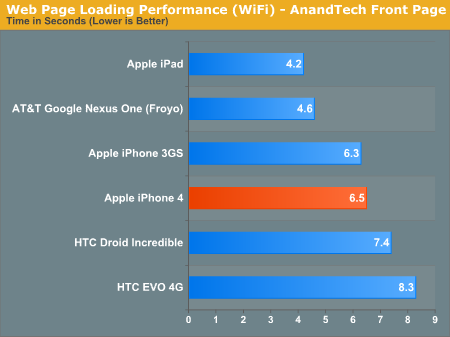
The iPhone 4 is no faster than the 3GS (actually slightly slower, but we'll chalk that up to timing variance) here. The Froyo update to the Nexus One makes it lightning quick, almost as fast as the iPad in our first test.
Next up we have the first page of our recent Zotac XBOX HD-ID11 review. The balance shifts from tons of images to more HTML processing:
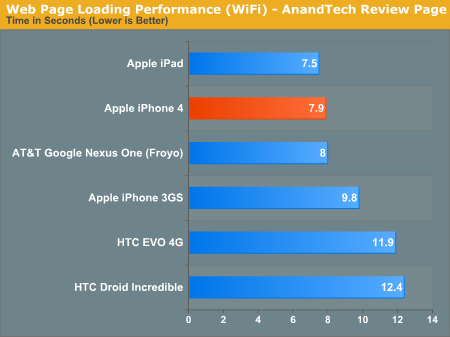
Here we see more of what I expected: the iPhone 4 is around 25% faster than the 3GS running iOS 4. Android 2.2 running on the Nexus One is basically as fast as the 4.
Using our Print this Review function, this next test loads our entire 2010 15-inch Macbook Pro review. While the other two tests had some flash ad content, this one is completely devoid of it so the HTC phones shouldn’t be penalized:
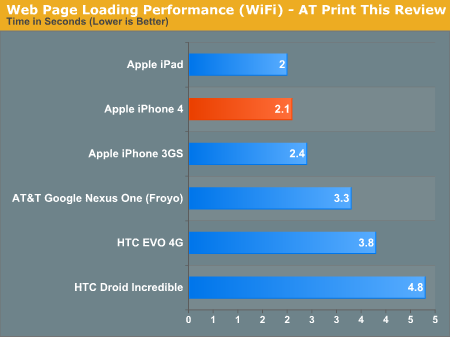
Here the iPhone 4 is 11% faster than the 3GS and about the speed of the iPad. There are other bottlenecks at play here so we don't get further performance scaling. The Froyo update helps the Nexus One a bit but the iOS devices are still quicker.
Our most intensive test is up next with a load of the Engadget front page:

The Nexus One is ahead of the 4 once more with its Froyo update. And the iPhone 4 is 34% faster than the 3GS.
Our most CPU bound test is up next. I put together a custom page with a ton of tabular content and a single page copy of our 15-inch MBP review to make the load take some time at least.
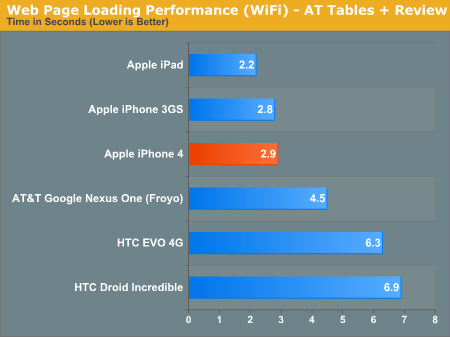
Surprisingly enough there's no difference between the 3GS and the 4 here, perhaps my test is less CPU bound than I thought. Froyo improves the Nexus One's performance a little bit.
Low Level Synthetic Tests
If we assume that we’re mostly CPU bound in all of these cases (a fair assumption given how fast Atom can run through all of these tests), then we’d be looking at a ~750MHz clock speed for the iPhone 4’s A4 assuming no other architectural changes. That’s actually a pretty big assumption. The A4 is widely believed to be a 45nm SoC using an ARM Cortex A8. At 45nm there should be room for a larger L2 cache than what was used in the iPhone 3GS’s SoC.
Perhaps some more synthetic tests will help us figure out what’s going on. I turned to Geekbench, now available in an iOS version.
Geekbench spit out a number of overall results that gave me a good enough summary of what’s going on to make an educated guess:
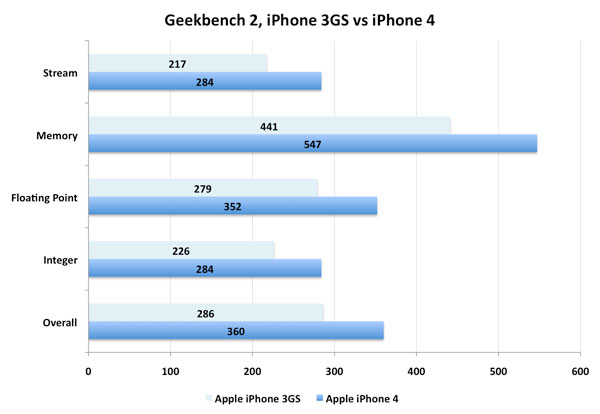
The CPU specific tests all indicate the iPhone 4 is around 25% faster than the iPhone 3GS. That would imply at least a 750MHz clock speed if all else is the same. Assuming we don’t get perfect CPU scaling with all of these tests, I’d venture a guess that 800MHz is more accurate. If the A4 does indeed have larger caches however, Apple could get away with a lower clock speed.
The memory results are particularly telling as they all scale very well going to the iPhone 4, better than the CPU results in fact. This could lend credibility to the theory of larger internal caches or perhaps to an improved (faster) memory subsystem.
Unfortunately until we get the iPad on iOS 4 we can't get a better idea of CPU scaling. I'm not even sure how reliable that will be at this point. If Apple was willing to change the amount of memory the A4 package housed between the iPad and iPhone 4, who is to say that it wouldn't have a slightly different design for the iPhone 4 (e.g. larger caches). The designs may not be physically different but we may instead be looking at binning. Given Apple's unwillingness to talk about the architecture here I think the safest bet is that we're looking at an 800MHz ARM Cortex A8 core in the iPhone 4 and a 1GHz core in the iPad.
Why the lower clock? It's all about battery life.










270 Comments
View All Comments
MacTheSpoon - Wednesday, June 30, 2010 - link
Hi, thanks for a really great review (I hope this isn't a double post, I had a problem when I submitted this before). I especially liked the hard numbers you used to measure things. Seeing the screen black levels, brightness, and contrast, plus how they compared to other phones, was really wonderful. I did have a few questions:1. Are you sure it's reasonable to conclude the maximum drop in signal strength when holding the phone is 24 dB? Doesn't skin capacitance vary from person to person? Also, I've seen some people put keys on their phones to connect the two antenna and demonstrate the reception problem, and I wonder if you could consider measuring the dB effect for that as well. Considering that keys are often kept in pockets with cellphones and could rest against the phones it seems like a reasonable scenario to explore.
2. Did you mention the problems people have had with the glass shattering easily? I've read many reports of this online. I didn't notice it but perhaps I did not read closely enough.
3. Since a case is, as you say, a must-have accessory for the phone, not only for the antenna but also apparently for the brittle enclosure, it seems unfair to give the phone credit for being 9.3 mm thin. Could you please give the thickness of the phone with the bumper? That seems to be its real thickness to me, honestly.
Thanks again for the review!
PhilBrandn - Wednesday, June 30, 2010 - link
See this video:http://vimeo.com/12951893
Even replicating the problem doesn't seem to force a dropped call.
MacTheSpoon - Wednesday, June 30, 2010 - link
It does, actually. Check this out:http://www.youtube.com/watch?v=03PQyWp0mWE
bill4 - Wednesday, June 30, 2010 - link
Cant shake the feeling of overwhelming Apple bias from most tech sites, and Anandtech.It doesn't help that it seems every tech editor's personal phone is an iPhone. And that's most certainly not because it's better, in fact in most cases the iPhone is objectively inferior to other phones.
This line in the article:
"On top of the battery life improvements Apple finally plays catch up and surpasses the technological advancements in its Android competitors. The 4's camera is as good as it gets today and the screen is a beauty. I don't believe this advantage will last for the lifetime of the iPhone "
Battery life is routinely massively overrated by Anand, it's simply not as important to most people as it seems to be to Anand. Charge your phone each evening and it's done. What's the big deal? Seems like the unnatural battery life obsession is just a way to give fake props to Apple in every review.
Likewise, "surpasses the technological advancements in its Android competitors. " Huh? Not hardly bud. By far the most important metric these days is screen size. Yes, it's probably not politically correct to say, I should talk about "usability" or some other subjective thing so we can pretend Apple is the winner, but it's the hard truth. Android phones have 4.3" and 4" screens aplenty. That's why I'm way more excited over the Evo, the Droid X, the Galaxy S, then a lame 3.5" iPhone revision. The iPhone 4 screen is actually (slightly) smaller than the 3GS screen (though they're both nominally 3.5" in screen area the 4 screen is smaller than the 3GS screen)! (Funny Anand never mentioned this fact once). Apple actually went BACKWARDs in this crucial area.
Then we have the weak 800mhz CPU vs the 1ghz+in many android models, etc etc.
Then we have the camera, worse in all respects to top droid phone cameras.
So in every relevant area except a currently meaningless one (resolution), the iPhone 4 objectively has worse specs than top Droid phones, already, yet Anand says it "surpasses the technological advancements in its Android competitors". OK, no bias there...
Overall, I just wish more reviews would call the 4 what it is, a small revision to the 3GS that falls short. Apple should have named it the 3GS+, it certainly doesnt deserve true succesor status. Hell, when sitting side by side, it's actually difficult to tell the 3GS and 4 apart, I guarantee no casual female (like, a Mom) could do it offhand. Your mom literally would not know which is supposed to be the "new" iPhone!
The Retina display is so much marketing BS. It's a small, typical incremental, completely non-revolutionary bump in resolution, yet dishonest tech sites are proclaiming it like it's somehow something tangibly new. More screen size would have been far more useful, the high PPI is truly almost completely useless compared to other 800X480 android phones, which are more than fine in that area as is. What's coming next Apple, 1080P on a 2.5" screen on the iPhone 5? Makes about as much sense. Screen size is objectively far, far more important than resolution on these phones, at least if they're 800X480 or above.
In the end I see another year of Apple losing share to the Droid phones, the 4 is a very minor change to the 3GS. Maybe next year Apple will do better.
I'm a good example, I'm limited to ATT, so I have few options, even though I dislike Apple, the iPhone 4 seemed like a good choice for me (only other option being the unsubsidized 529 Nexus One currently!), yet, there's just no way I'm going to settle for the no flash, small screen, iPhone 4.
kmmatney - Wednesday, June 30, 2010 - link
"And that's most certainly not because it's better, in fact in most cases the iPhone is objectively inferior to other phones."You pretty much lost your credibility right there..
About the battery life issue - it's huge - at least with people who travel a lot, like me. And I'm not about to carry an extra battery around.
JAS - Wednesday, June 30, 2010 - link
The iPhone 4 is a significantly greater upgrade over the 3GS than the 3GS was over the iPhone 3. The new A4 processor and doubling of the RAM make the iPhone 4 a noticeably faster device. Its improved camera and 720P video recording are additional noteworthy plusses.Yes, the Google Android OS is bound to be running on more smart phones than the Apple iOS by virtue of the fact that Andriod phones are available from more manufacturers and wireless carriers. The situation is not unlike the great abundance of computers that run Microsoft Windows versus the number of OS X Macintoshes in use. Only Apple sells Macs while MS Windows boxes are available from a wide range of manufacturers.
strikeback03 - Thursday, July 1, 2010 - link
Well the first phone I know of with a 4"+ screen was the HD2, but as it runs Windows Mobile that rules it out for a lot of people. In the US at least I don't think there are any 4" or bigger screens actually released other than the EVO, the Droid X doesn't come out for another few weeks and the Galaxy S class (shouldn't these have been named the Galaxy, Yamato, Enterprise...) do not have a firm release date yet.On the subject of battery life, if the phone cannot make it through your day (as he states previous iphones could not make it through his) then that can be a problem. Sure I would prefer a phone that can go 3 or 4 days without recharging, but until battery technology allows that to be pocketable I will live with lasting a full day. But if I start needing to have a charger at work and in my car just to make it through the day that is a problem. I do wish he would have some type of a more mixed battery life test though, after all I don't know anyone who is just going to sit and browse the web over 3G very often. How about a mix of (per hour) 10SMS, 3 min on voice call, 5 min web browsing, 5 min gaming, 5 min listening to music, checking email 4 times, and the rest of the time just flicking the screen on occasionally to check the time, or calendar, or a sports score, etc? How long could it last in a more general use scenario like that?
Mumrik - Friday, July 2, 2010 - link
"Battery life is routinely massively overrated by Anand"I can't get my head around why you'd ever say something like that. Having to recharge every night is a major hassle and completely unacceptable. We don't all sleep the same place every night or want to keep our chargers by the bed. Battery life is a huge issue right now as companies put more and more powerful and power consuming chips in phones while batter life suffers. It used to be normal to recharge you phone 1-2 times a week you know...
ale087 - Wednesday, June 30, 2010 - link
I see the Galaxy S as a direct competitor to the iPhone 4, the SoC has been said to be extremely similar... Please give us an in-depth review with awesome hardware info that we can't get anywhere else :-D Thanks for doing a great job as always! looking forward to that Galaxy S review ;-)navderek - Wednesday, June 30, 2010 - link
Are you really sure you know what your talking about when it comes to reviewing RF related topics? You seem to know the basics but I don't think you know enough to actually review handsets in this manner and your comments can be misleading.I work in the RF field as an RF Operations Specialist for a several large network that include iDEN, CDMA, and UMTS, as well as microwave and fiber optic transmission. Anyways this is not about me but I thought I would state this before continuing...
The signal bars do not always simply signify signal strength in decibels. For many handsets what the actually signify is signal QUALITY. This could be SNR as you mentioned in your article however it is not so simple...
For example, in an iDEN network the quality measurement is "SQE" and for a UMTS network (or as we like to call it - 3G network), the first and foremost quality measure is "CQI"
Lets use the CQI metric in UMTS for our example...CQI values will determine the coding technique used by the serving BTS (tower) which will determine how many redundant bits to send to keep the BER low as well determine which modulation scheme to use (i.e. different levels of QAM, like 64QAM in the best quality scenario).
Now I won't go into detail here about how all this works and how it's tied into the graphical representation of the bars you see on the handset but I will let you in on something...over the years those bars have become less and less reliable as a measure of signal strength and/or quality. Why? Because cellular carriers don't want clients to see less than 5 bars, so they have been pretty much rigged to display 5 bars in most situations until the signal is VERY BAD.
Finally, about your coments in regards to signal strength in decibels...-107dB is extremely
bad for a signal on any network. You stated that for voice and data that -107dB is perfectly fine...this could not be further from the truth and this is the point where the signal levels out with the noise floor. The BTS and/or UE begin to really lose communication with eachother at this level and on top of that you'll never get good data rates at such a poor signal level with UMTS for reasons stated above. At that signal level (-107dB) the BTS will be sending a ton of redundant bits with the most redundant coding technique as well as factoring down the QAM constallation in an attempt to keep the link alive. The data may still work in some cases at -107dB but your speeds will suffer GREATLY.
Please consider hiring an RF expert before making generalized RF based reviews. I highly respect your reviewing cabability and your intelligence, however I question your wisdom when you do such a review.
Thanks